
SAE International Journal of Vehicle Dynamics Stability and NVH
Scope & Guideline
Elevating Standards in Automotive Engineering Excellence
Introduction
Aims and Scopes
- Vehicle Dynamics and Control:
Research on vehicle dynamics encompasses the study of motion, handling, and stability of vehicles. This includes control strategies for various vehicle systems such as suspension, braking, and traction control to enhance performance under different driving conditions. - Noise, Vibration, and Harshness (NVH) Analysis:
The journal emphasizes the investigation of noise, vibration, and harshness effects on vehicle performance and passenger comfort. This includes studies on sound design, vibration suppression, and comfort improvement methodologies. - Electric and Hybrid Vehicle Technologies:
There is a strong focus on the dynamics and control of electric and hybrid vehicles, particularly in relation to their unique NVH characteristics and performance optimization through innovative control systems. - Autonomous and Connected Vehicle Research:
Research articles often explore the dynamics, control strategies, and safety aspects of autonomous and connected vehicles, reflecting the growing importance of these technologies in the automotive sector. - Advanced Materials and Structural Dynamics:
The journal includes studies on the use of advanced materials and structures in vehicle design to improve dynamics, safety, and ride comfort, particularly through innovative suspension systems and chassis designs.
Trending and Emerging
- Smart and Adaptive Control Systems:
There is an increasing focus on the development of smart control systems that adapt to changing driving conditions and driver behavior, which is essential for enhancing vehicle safety and performance. - Integration of Machine Learning and AI:
The use of machine learning and artificial intelligence in vehicle dynamics and control strategies is on the rise. This includes applications for predictive modeling, real-time decision-making, and enhanced NVH analysis. - Sustainability and Energy Efficiency:
Research related to improving energy efficiency in electric and hybrid vehicles, particularly through regenerative braking and optimized energy management systems, is gaining prominence. - Human Factors and Driver Behavior Analysis:
Emerging studies increasingly consider the impact of human factors on vehicle dynamics and control, including how driver behavior influences vehicle stability and safety. - Advanced Simulation Techniques:
There is a growing trend towards using advanced simulation techniques, including hardware-in-the-loop and real-time simulations, to test and validate vehicle dynamics models and control strategies.
Declining or Waning
- Traditional Mechanical Systems Analysis:
Research focusing solely on conventional mechanical systems without integration of advanced technologies is becoming less prominent as the field moves towards more sophisticated, integrated approaches that leverage electronics and software. - Basic Vehicle Handling Studies:
Basic studies on vehicle handling, which do not incorporate modern computational methods or advanced control strategies, are declining as the field increasingly values complex, data-driven approaches. - Static and Linear Analysis Methods:
There is a noticeable shift away from static and linear analysis methods in favor of dynamic, real-time analysis techniques that better reflect the complexities of modern vehicle operation and control. - Single-Factor Studies:
Research that examines isolated factors affecting vehicle dynamics is waning as multidisciplinary approaches that consider multiple interacting factors become more valuable and relevant.
Similar Journals
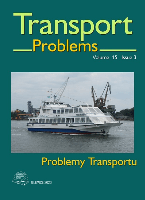
Transport Problems
Unlocking Insights in Transportation Systems and TechnologiesTransport Problems, published by the Silesian University of Technology, Faculty of Transport, is a distinguished open-access journal that has been advancing scholarship in the fields of Automotive Engineering, Mechanical Engineering, and Transportation since its inception in 2007. With an ISSN of 1896-0596 and an E-ISSN of 2300-861X, this journal serves as a vital platform for researchers and practitioners to disseminate innovative research findings and explore fundamental issues in transport systems and technologies. Based in Poland, the journal covers various topics including transportation logistics, vehicle dynamics, and environmental impacts, thereby addressing critical challenges faced in the transportation sector globally. As reflected in its Scopus rankings, the journal occupies respectable quartiles and continues to contribute valuable insights to the academic community. By making its content freely accessible, Transport Problems significantly enhances the ability of researchers and students alike to engage with the latest developments in transport engineering and contribute to this ever-evolving field.
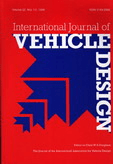
INTERNATIONAL JOURNAL OF VEHICLE DESIGN
Fostering Excellence in Automotive Design and TechnologyThe INTERNATIONAL JOURNAL OF VEHICLE DESIGN is a distinguished publication that has been at the forefront of automotive engineering and mechanical design since its inception in 1979. Published by INDERSCIENCE ENTERPRISES LTD in the United Kingdom, this journal aims to foster innovative research and technical knowledge in the field of vehicle design, encompassing various aspects from conceptualization to manufacturing and performance analysis. With an ISSN of 0143-3369 and an E-ISSN of 1741-5314, the journal extends its accessibility to a global audience, although it currently does not operate under an open access model. Recognized for its scholarly contributions, it holds a Q3 ranking in Automotive Engineering and a Q4 ranking in Mechanical Engineering as of 2023, reflecting its position among peers with an increasing impact in the discipline. Researchers, professionals, and students will find valuable insights and cutting-edge research in the articles published, contributing to a deeper understanding of advancing vehicle technologies and methodologies. For inquiries, the journal is based at the World Trade Center Building, 29 Route de Pré-Bois, Case Postale 856, CH-1215 Geneva, Switzerland, where one can also follow its developments and contribution to the growing body of knowledge in vehicle design.

Journal of Unmanned Vehicle Systems
Fostering global dialogue on unmanned vehicle innovations.Journal of Unmanned Vehicle Systems, published by CANADIAN SCIENCE PUBLISHING, is a leading peer-reviewed journal dedicated to advancing the field of unmanned vehicle technology. With an ISSN of 2291-3467, this journal provides an essential platform for researchers and professionals interested in the intersection of engineering, computer science, and control systems as they pertain to unmanned vehicles. The journal has achieved commendable rankings in Scopus, including a rank of #17/118 in Mathematics - Control and Optimization and #23/131 in Aerospace Engineering, reflecting its impact in these significant areas. As an open-access journal, it fosters global collaboration and accessibility, ensuring that innovative research in unmanned vehicle systems reaches a broad audience. The journal's objectives are to publish high-quality research articles, technical notes, and reviews that contribute to the understanding and development of autonomous systems. With its coverage spanning from 2013 to 2021, the Journal of Unmanned Vehicle Systems remains a vital resource for advancing discussions and knowledge in this rapidly evolving field.
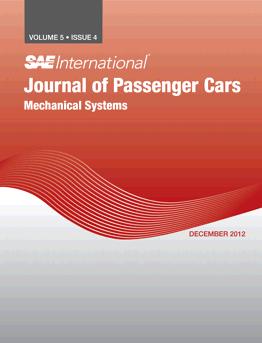
SAE International Journal of Passenger Cars-Mechanical Systems
Driving Innovation in Automotive MechanicsSAE International Journal of Passenger Cars-Mechanical Systems, published by SAE International, serves as a vital platform for researchers, engineers, and industry professionals focused on the dynamics of passenger vehicle mechanical systems. With an ISSN of 1946-3995 and E-ISSN of 1946-4002, this journal bridges academic research with practical applications in the automotive field. Although coverage in Scopus was discontinued after 2021, the journal has still contributed significantly to the realms of automotive engineering, safety, and mechanical engineering, evidenced by its Scopus rankings and percentiles across various categories, including a rank of #57 in Automotive Engineering. This multidisciplinary journal is key for those looking to advance their knowledge and explore innovative solutions in automotive mechanics, with an emphasis on enhancing vehicle performance, reliability, and safety. While current open access options are detailed further on their website, the journal continues to maintain a commitment to disseminating valuable insights that can shape future automotive technologies and practices.
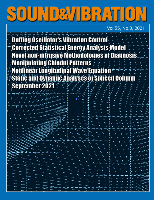
SOUND AND VIBRATION
Bridging Theory and Application in AcousticsSOUND AND VIBRATION, published by TECH SCIENCE PRESS, is a pivotal journal in the fields of Acoustics and Ultrasonics, Mechanical Engineering, and Safety, Risk, Reliability, and Quality. With an ISSN of 1541-0161, this journal has been a reliable source of innovative research and developments from its inception in 1976 through to 2024. Although it currently ranks in the Q4 category on Scopus, it serves as a vital platform for the dissemination of studies focusing on sound and vibration phenomena, contributing to the understanding and advancement of engineering principles. Researchers and professionals are encouraged to utilize this journal to gain insights into critical acoustic applications and mechanical dynamics. While SOUND AND VIBRATION does not operate under an Open Access model, it remains a valuable asset for anyone committed to exploring the various ramifications of sound and vibration in engineering and applied sciences.
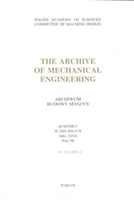
Archive of Mechanical Engineering
Exploring the Dynamics of Materials and MechanicsThe Archive of Mechanical Engineering, published by Polska Akademia Nauk (Polish Academy of Sciences), is a distinguished platform for disseminating cutting-edge research in the fields of Mechanical Engineering and Mechanics of Materials. Since its inception, the journal has evolved and embraced an Open Access model since 2010, thereby enhancing accessibility and fostering wider dissemination of knowledge among researchers, professionals, and students globally. The journal covers a broad spectrum of topics, ensuring that vital advancements in mechanical engineering are communicated effectively. Recognized as a Q3 category journal in both its relevant categories as of 2023, the Archive continues to establish itself with a competitive Scopus Rank, aiming to elevate the standard of research and innovation. By merging historical insights with contemporary advancements, the journal serves as an essential resource for those seeking to delve into the evolution and future of mechanical engineering.

Ingineria Automobilului
Pioneering Advances in Automotive TechnologyIngineria Automobilului is a prominent journal dedicated to advancing knowledge in the field of automotive engineering. Published by the SOC AUTOMOTIVE ENGINEERS ROMANIA, this journal serves as a vital platform for the dissemination of high-quality research, innovative methodologies, and groundbreaking applications in automotive technology. With an ISSN of 1842-4074, it provides an essential resource for researchers, professionals, and students who are committed to the development and enhancement of automotive systems. Although the journal currently does not offer open access, its contributions are crucial for ongoing advancements in automotive design, safety, and sustainability. The publication aims to foster collaboration between academia and industry, emphasizing the importance of interdisciplinary approaches in solving complex challenges facing the automotive sector today. By facilitating discussions on emerging technologies and engineering practices, Ingineria Automobilului continues to play a pivotal role in shaping the future of automotive engineering.
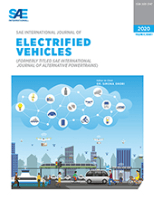
SAE International Journal of Electrified Vehicles
Accelerating Knowledge in Electrified Vehicle TechnologiesSAE International Journal of Electrified Vehicles, published by SAE International, is a pioneering journal dedicated to the field of electrified transportation. Operating since 2020, this journal offers a crucial platform for researchers, engineers, and practitioners who are at the forefront of advancements in vehicle electrification and related technologies. With an ISSN of 2691-3747 and an E-ISSN of 2691-3755, it is indexed within respected databases, showcasing its commitment to high-quality research in Automotive Engineering and Fuel Technology. As part of the Q3 category in the 2023 rankings for both automotive and energy sectors, the journal facilitates the exchange of innovative ideas and groundbreaking studies that contribute to the evolution of the electrified vehicle industry. While currently not open access, the journal offers various subscription options for readers, making valuable insights accessible to a broad audience. Conducting research in this dynamic field, the SAE International Journal of Electrified Vehicles is vital for professionals striving to push the boundaries of technology and sustainability in modern transportation.

Journal of Building Engineering
Driving Quality and Reliability in Engineering PracticesWelcome to the Journal of Building Engineering, a premier platform for the dissemination of innovative research in the fields of Architecture, Building and Construction, Civil and Structural Engineering, Mechanics of Materials, and Safety, Risk, Reliability and Quality. Published by ELSEVIER and based in the Netherlands, this journal has solidified its reputation as a leader in the field, proudly achieving a prestigious Q1 ranking across multiple categories as of 2023. With a remarkable impact in Scopus, including being ranked #1 in Architecture and consistently placing within the top 20 in other critical disciplines, the journal is dedicated to fostering high-quality research that addresses contemporary challenges in building technology and engineering practices. The E-ISSN 2352-7102 further facilitates access to groundbreaking articles from 2015 to 2024, making it a vital resource for researchers, industry professionals, and students alike. Embrace the opportunity to engage with cutting-edge studies that not only contribute to academic dialogue but also influence practical applications in the rapidly evolving landscape of building engineering.
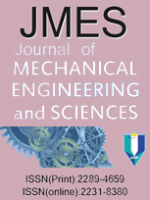
Journal of Mechanical Engineering and Sciences
Bridging Theory and Application in Engineering ExcellenceThe Journal of Mechanical Engineering and Sciences (ISSN: 2289-4659, E-ISSN: 2231-8380), published by UNIV MALAYSIA PAHANG, is a prominent open access journal established in 2011, dedicated to advancing the field of mechanical engineering and associated sciences. Covering a wide array of topics from industrial manufacturing processes to computational mechanics, the journal serves as a vital platform for researchers, professionals, and students to disseminate innovative findings and methodologies. With impressive Scopus rankings, including a place in the 60th percentile for Industrial and Manufacturing Engineering, the journal holds a significant position among its peers, facilitating global academic discourse. Located in Kuantan, Pahang, Malaysia, the journal emphasizes accessibility and collaboration within the engineering community, encouraging submissions that contribute to both theoretical and applied aspects of mechanical engineering.